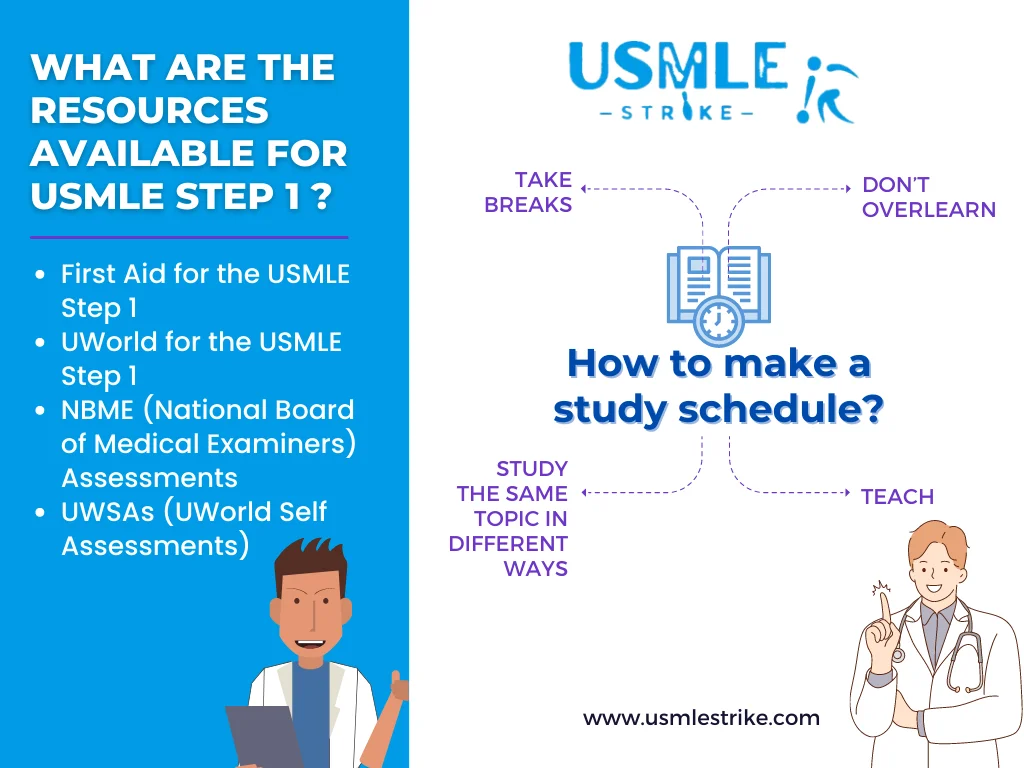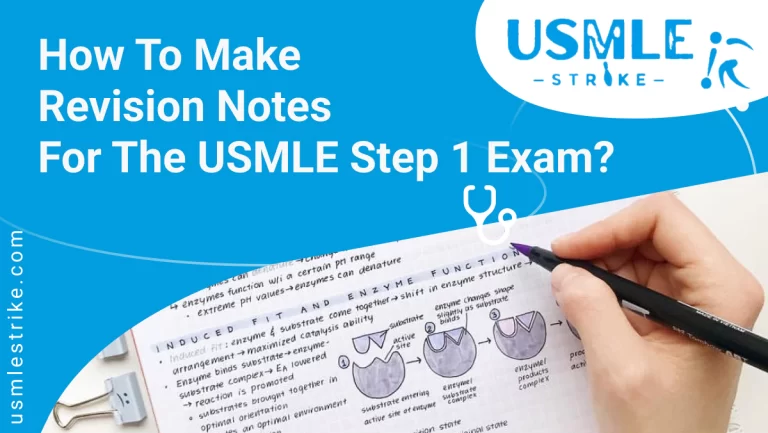The United States Medical Licensing Exam(USMLE) is a tough and challenging exam for everyone, no matter how well you did in school. It is the exam that you need to obtain a license to study or work in medicine in the USA. There is a word that says failure is a stepping stone to success!! If you failed once without supervision, here is a golden opportunity for you to excel with the help of comprehensive revision notes for the USMLE.
USMLE Strike the Best USMLE coaching centre will help you!! If you prefer USMLE, then the USMLE strike gives a quality USMLE Coaching Program for the USMLE Step 1 exam.
There are a few ways to prepare for USMLE Step 1 exam!!! Here are some step-by-step hacks that can help you while preparing and getting a good score.
Always adopt a three-stage approach: This is an effective way for preparing USMLE Step 1 exam.

Creating Effective Revision Notes for the USMLE Step 1 Exam
Creating effective revision notes for the USMLE is crucial for successful preparation. When crafting your revision notes for the USMLE, it’s essential to follow a structured approach. Here are some tips on how to make comprehensive and efficient revision notes for the USMLE:
- Understand the Exam Content:
- Commence your preparation by closely examining the content outline of “USMLE Step 1” to gain a comprehensive understanding of the primary subjects and focal points of the examination.
- Use High-Quality Study Resources:
- Select reputable study materials, such as textbooks, online resources, and question banks, known for aligning well with the “USMLE Step 1” exam content. Integrating these resources into your revision notes ensures a comprehensive and reliable study foundation.
- Organize Information:
- Structure your revision notes for the USMLE by creating a well-organized outline or utilizing a dedicated notebook. This organization should categorize information by subject, allowing for a systematic and targeted review.
- Highlight Key Concepts:
- While reading, employ highlighters or different colors to emphasize essential concepts within your revision notes for the USMLE. This visual distinction will draw attention to key facts, principles, and details frequently tested in the exam.
- Create Visual Aids:
- Enhance your revision notes for the USMLE by incorporating visual aids such as charts, diagrams, and tables. These visuals serve to simplify complex information, making it easier to remember and understand.
- Condense Information:
- Ensure that your revision notes for the USMLE maintain brevity by summarizing lengthy paragraphs or explanations into concise points. This focused approach helps retain essential information without overwhelming details.
- Include Mnemonics and Memory Aids:
- Develop and integrate mnemonics and memory aids directly into your revision notes for the USMLE These memory-enhancing tools can be particularly powerful in recalling complex information during the exam.
- Review and Revise Regularly:
- Schedule regular review sessions to reinforce your understanding and commit the information in your revision notes for the USMLE to memory. Frequent revision is key to solidifying the knowledge needed for success.
- Practice with Questions:
- Integrate practice questions directly into your revision notes for the USMLE. Analyzing both correct and incorrect answers will enhance your understanding of the material and reinforce your exam readiness.
- Create a Personalized Resource:
- Make your revision notes for the USMLE a personalized resource that aligns with your unique learning style. Include annotations, comments, or references that resonate with you, creating a more tailored and effective study tool.
- Prioritize Weak Areas:
- Identify your weak areas and prioritize them within your “Revision Notes for the USMLE.” Allocating additional study time to these topics ensures a targeted approach to improving your overall readiness for the exam.
- Simulate Exam Conditions:
- Incorporate timed, full-length practice exams into your study routine to simulate real exam conditions. This practice enhances your time management skills and stamina, preparing you thoroughly for the “USMLE Step 1” exam.
In summary, the creation of effective revision notes for the USMLE involves a thoughtful and strategic approach, incorporating these tips to maximize your preparation and increase your chances of success on the exam.
Disciplines Covered in Step 1
Here’s a table outlining the disciplines covered in the USMLE Step 1 exam:
| Discipline | Description |
| Anatomy | Gross anatomy, histology, embryology |
| Behavioral Science | Biostatistics, epidemiology, patient interactions |
| Biochemistry | Molecular biology, metabolism, genetics |
| Microbiology | Bacteriology, virology, parasitology, mycology |
| Immunology | Immune system function and disorders |
| Medical Genetics | Inherited disorders, genetic principles |
| Nutrition | Normal nutrition, nutritional disorders |
| Aging | Normal aging, geriatric syndromes |
| Molecular and Cell Biology | Cell structure, cellular processes, molecular biology |
| Histology | Tissues, cells, and organs at the microscopic level |
| Social Sciences | Cultural competence, ethics, communication |

Terms and Definitions
The first step is that learn some basic terms and definitions of your specific subjects. You should remember the terms and definitions in short you can say the “terminology” You should learn all of the terms and definitions of your respective topic so that it will be easy for you to attend the exam without fail. Need to understand all terms and definitions, so less likely to blank during your exam.
During this stage, create a short way to learn terms and definitions. Mnemonic devices and word associations are best that can help you to memorize. Apart from that, you can take help from any professional like Usmle strike, their expert will help you to make better learning while providing USMLE Coaching Program for USMLE Step 1 preparation
Central Concepts
The USMLE Step 1 exam has 7 subjects and you have to master all !! You have to learn all the central concepts of each subject to qualify for the exam.
This USMLE Step 1 preparation needs to learn how to explain these concepts, with their usage and their connection to other ideas of the concept.
Try to learn Visual aids like pictures and diagrams, which are extremely helpful during this stage. Because it will enhance your creativity to form images of each concept. Learning about each concept’s mental image will help you identify the patterns within each of the seven subjects. Always be sure you have a base recollection of all your central concepts.
Application
Practical application is also important to stage to crack the USMLE Step 1 exam. It involves taking the central concepts and using them in clinical and mini-case presentations.
Book studies are the best method for USMLE Step 1 preparation, but using your ability to apply is as important to crack this USMLE examination as well. Only understanding the concepts underlying each subject area is not enough, you have to develop the ability to apply them appropriately in given situations.
You and your fellow can practice tests to examine your potential in which you are best!! Like connecting visual ideas, identifying the pattern, image, terminology, etc. Group studies will also help to excel USMLE Step 1 exam
What are the Sample Test Questions for USMLE Step 1 Exam?
Sample test questions for USMLE Step 1 Exam are made available to examinees to become familiar with the examination type, format, and difficulty level. In addition, the examination questions are also used by medical schools as sample test questions for their preclinical medical courses and exams.
The sample questions are available on the USMLE Strike website for medical graduates who want to ace this USMLE Step 1 Exam. The USMLE sample test questions are made available to examinees as a resource to review in preparation for the USMLE Step 1 Exam.
USMLE Step 1 Sample Questions: Most Up to Date USMLE Step 1 Sample Questions – From UWorld, First Aid, Best USMLE Step 1 QBank, Best USMLE Step 1 Online Course, Best USMLE Step 1 Review Course and Uworld Step 1 Question Bank.
How the Sample Test Questions for USMLE Step 1 Exam are designed?
If you want to get an idea, of how the USMLE Step 1 Sample Questions are designed, then you can see the structure of the actual Step 1 exam at the USMLE Strike website. It’s not a secret that the USMLE Step 1 Sample Questions are designed based on the structure of the actual exam, so you should have a look at the official USMLE website usmlestrike.com if you are interested in the preparation.
And here you have the structure of the actual exam, so you can see, how the USMLE Step 1 Sample Questions are designed, although the real exam is a bit different from the Sample Questions.
Conclusion
In this blog, you will surely know the step-by-step USMLE Step 1 preparation apart from that you can get an idea of the fee structure. There is a saying when there is will there is a way!! Get the proper way, to accomplish your dream, and here is the step discussed above.
Read also : USMLE Step 2 CK Notes





